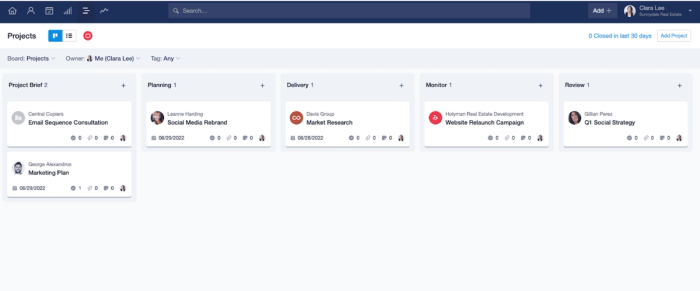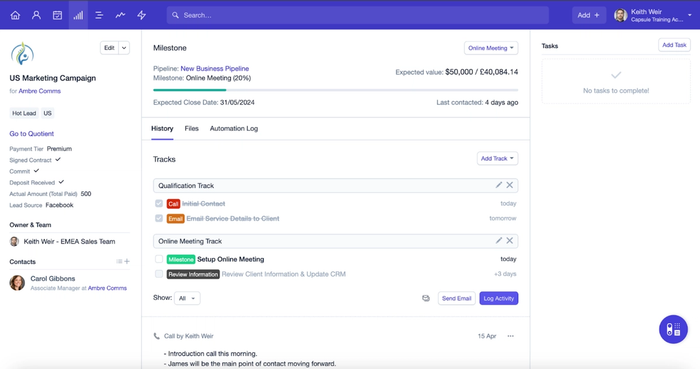Many businesses focus on the sales process, and understandably so. More customers usually means more revenue. However, the reality is that closing a deal is just the beginning. You need to be able to retain those new customers, which means delivering a high-quality solution and helping them get the full value out of it.
Project management is a great way to handle the post-sale process. Unfortunately, many companies fail to bridge the gap between sales and project execution. Without a seamless transition, critical information can be lost, projects can fall off track and client relationships can suffer.
In this article, we’ll see how you can make the jump from the sales pipeline to project management with best practices and tools that ensure a flawless handover and successful project outcomes.
Understanding the sales pipeline
Before we get into how to transition from a sales process to delivering your solution, let’s look at the sales pipeline. A sales pipeline is a visual representation of the sales process, showing all the stages that a prospect goes through from initial contact to closing the deal.
The specific stages can vary across businesses, depending on the customer journey. The default stages in Capsule CRM are:
- New
- Qualified
- Meeting
- Proposal
- Negotiation
- Contract
If your sales process uses different stages, you can fully customize the pipeline to reflect how your sales team operates.

We’ve previously covered how to build your first sales pipeline and tips for a successful pipeline in other guides, but here we’re particularly interested in the final stages leading up to the close. By taking the initiative and laying the groundwork for future projects in these stages, you’re more likely to have a smooth transition post-sales.
For example, during the proposal stage, you’re typically creating and presenting tailored quotes to qualified leads, outlining how your solution meets their needs. This is a great time to involve the teams responsible for delivering the finished product, to ensure they understand the customer needs and can prepare for any necessary changes.
Similarly, the negotiation stage is an ideal time to confirm the scope and timelines, both internally with your team and externally with the customer. Not only does this help you with resource allocation, but it also builds client confidence and trust by demonstrating your professionalism and commitment to a successful outcome.
Tools and techniques for transitioning from sales to projects
While some early preparation with the teams responsible for delivering the project is a good start, the right tools and best practices can help you smoothly make the jump and provide the best possible customer experience. Here are some essentials for your toolbox:
CRM and project management software
The most common challenges you’ll face generally revolve around communication, either between your internal teams or between your teams and the customer. The right software can go a long way to helping keep everyone on the same page, so there are no unexpected customer requests or missing resources.
Customer relationship management (CRM) software lets you capture every important detail about your customers and their requirements in one central location.
For example, with Capsule CRM, you can see a complete history of your customer interactions, including emails, calls, files, notes and more. Rather than having to sift through separate apps, the quick search feature means you can quickly find key client information whenever needed.
When it comes to post-sales, you’ll need a way to manage the project. With a CRM designed for project management, you can handle both sales and project delivery all from the same platform. Capsule includes user-friendly kanban boards, giving you a quick overview of all your projects to see where they are in the process.

Team and project managers can monitor the entire team’s workload, assign tasks and identify potential bottlenecks.
Capsule also comes with a mobile app, enabling you to manage sales and projects in your office, meeting with clients or anywhere else.
Checklists and templates
The transition between sales and projects can be tricky. As you move the customer from one team to another, it’s easy to make mistakes; responsibilities may be unclear or crucial information may fall through the cracks.
By standardizing procedures, checklists and templates help your teams maintain clarity and focus, ensuring every detail is covered and no step is missed.
For example, a handover checklist ensures your teams have all the details they need before moving forward. Depending on your type of business, this could include details like:
- Key stakeholder contact information
- Project deliverables and milestones
- Agreed deadlines
- A copy of the signed contract
- Previous communications
- Relevant files and documents
- Any outstanding tasks and issues.
Capsule’s Tracks feature lets you create templated task lists for your teams, showing them what needs to be done for each step in the process. As you tick off each item, you can record notes and see what’s next on the list.

Automated workflows
While your checklists enable teams to see what they should be working on, in many cases it’s possible to automate a lot of the steps. Workflow automation reduces the potential for human error and task duplication, improving efficiency and freeing up your team to focus on high-touch activities that elevate the customer experience.
For example, Capsule’s Growth plan lets you automatically assign tasks to your team, send follow-up reminders, update task statuses and more.

Remember that automation should complement, not replace, human oversight. While automated workflows can handle routine tasks efficiently, critical decision-making and strategic planning should always involve input from you and your team. By balancing automation with human expertise, your projects are more likely to run smoothly and meet their objectives.
A step-by-step guide to managing the transition from sales to projects
Navigating the shift from sales to project management requires a clear plan and structured approach. These steps will guide you through the process.
Step 1: Prepare during the sales process
The sooner you start preparing for the project, the more likely you are to enjoy a successful project outcome. As we’ve touched on earlier, this means you need to be thinking about the project while you’re still in the sales process.
Collect detailed information about the client’s needs, goals and potential challenges. Document all of these details, alongside records of your customer interactions, inside your CRM. By using your CRM as the single source of truth for your organization, all of your teams can access the information they need without worrying about whether it’s up to date.
You should also get the project management team involved early on to get their insights and ensure the project is feasible. Establish preliminary timelines and identify key milestones to set realistic expectations.
A successful project is about more than just data though. Use the sales process to introduce the client to the project management team so they can start building rapport. By creating a collaborative relationship between your teams and the client, you’re laying a strong foundation for a smooth transition.
Step 2: Conduct a formal handover meeting
Once the sale is finalized, schedule a formal handoff meeting between the sales and project management teams. Prepare a comprehensive handoff document capturing contact details, client requirements, contractual details and the project timeline, to ensure everyone is on the same page.
During the meeting, the sales team should share the key insights they picked up during the sales process, emphasizing client expectations, preferences and any potential challenges identified. While your CRM should have all this information recorded, this is an ideal opportunity to clarify any ambiguities and answer questions.
Step 3: Prepare for kickoff
Following the handoff, the project manager should carry out a detailed kickoff meeting with the internal team and the client. Begin the meeting with a clear presentation of the project scope, objectives and deliverables to ensure everyone understands the project’s goals.
Next, focus on stakeholder alignment and communication planning. Identify all project stakeholders, including clients, team members and any external partners. You can then develop a comprehensive communication plan, specifying the types and frequency of updates.
For example, you might have weekly internal meetings for tracking progress alongside monthly client reports. Establish preferred communication methods, whether through email, project management software or face-to-face meetings, including how urgent issues or questions should be handled.
Step 4: Allocate your resources
One of your most valuable resources is your project team. Use this step to assess your team’s skills and availability. Match team members to tasks based on their expertise, ensuring their workloads are balanced and manageable.
You’ll be in a position to develop a detailed project schedule, outlining key activities, deadlines and dependencies. Use your CRM’s project management features, such as kanban boards and task lists, to visualize assignments and track progress.
In line with your communication plan, communicate the task assignments and deadlines to all team members, ensuring they individually understand their roles and responsibilities. Continuously monitor team workloads and be prepared to reallocate resources as necessary to address any imbalances or bottlenecks.
Step 5: Monitor and adjust
As well as monitoring your team’s workload, you must be able to monitor the overall project performance and make adjustments where necessary. Before you start working on the project, you need to define what success looks like.
Identify key performance indicators (KPIs) that align with the project’s goals and the client’s expectations. Share these metrics with all stakeholders to ensure everyone has a clear understanding of the project’s targets.
As the project progresses, use these KPIs and project management tools to continuously monitor performance and track alignment with the plan. Use your scheduled meetings to review milestones, assess performance and identify any issues or deviations from the plan.
Address any problems promptly, making necessary adjustments to resources, timelines and strategies to keep the project on course. Maintain open and transparent communication with all stakeholders, keeping them informed of progress and any changes.
Seamless transitions for successful outcomes
Closing the deal is an exciting moment for any business, but you also need to follow that up with successful projects. By following best practices, leveraging the right tools and techniques, and implementing a structured approach, you can bridge the gap between sales and project execution seamlessly.
Remember, the key to a smooth transition lies in early preparation, clear communication and ongoing monitoring and adjustment. By prioritizing a smooth transition from sales to project management, you not only increase the likelihood of delivering high-quality solutions but also foster trust and confidence with your clients. This commitment to excellence will ultimately lead to increased customer satisfaction, stronger relationships and a competitive edge in your industry.
Discover how a CRM can help with both your sales pipeline and your project management. Enjoy Capsule’s free starter package or start a 14-day free trial and see how Capsule’s features help sales and project delivery teams collaborate and connect with your clients.




